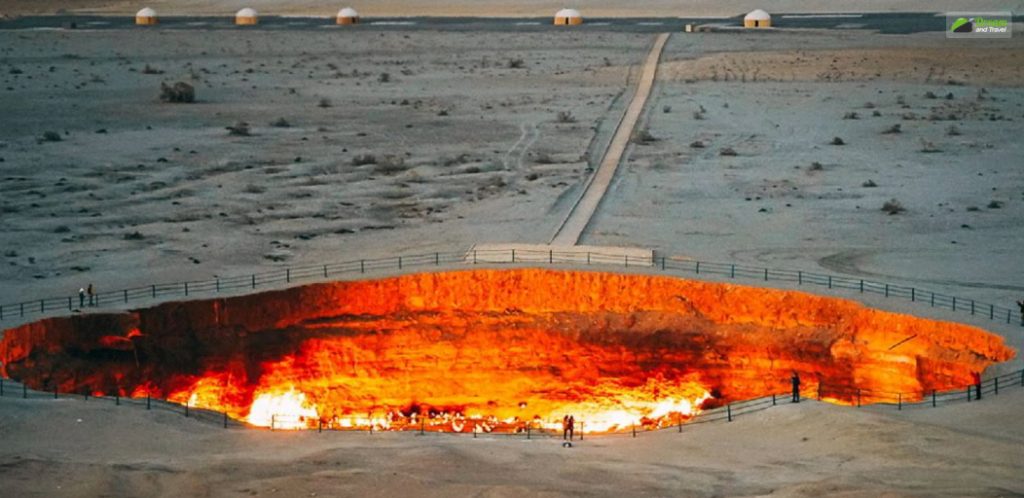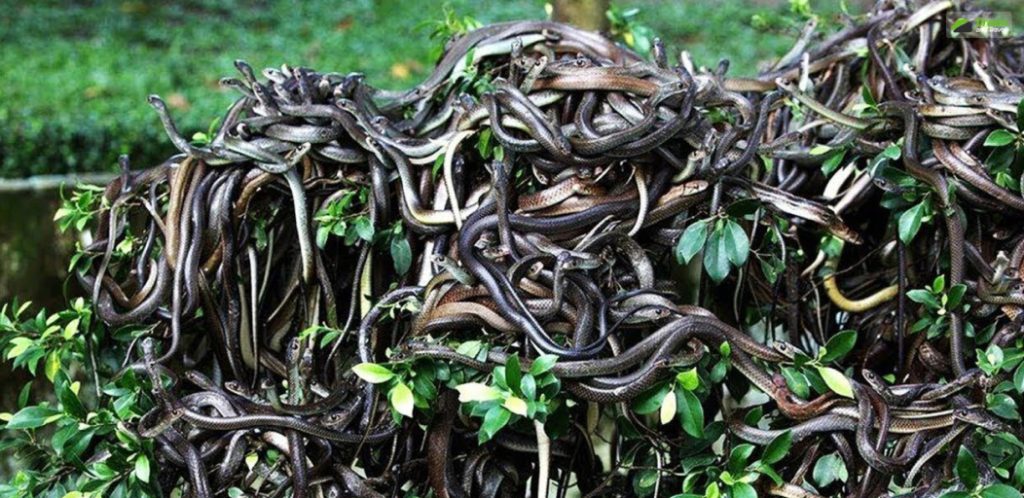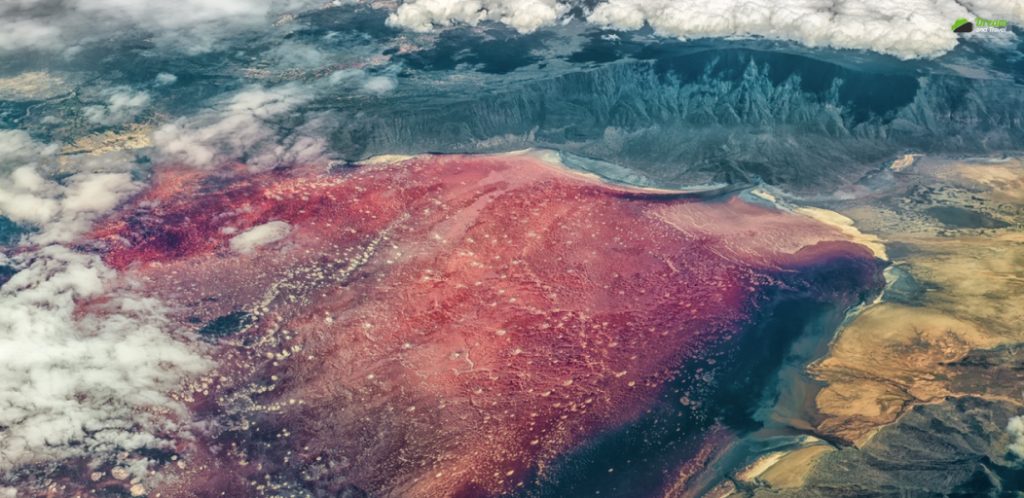Not all pretty things are as approachable as they seem. Some of the spots on the face of this earth prove it by rubbing it in our faces. Usually, the places referred to look extraordinarily beautiful and Instagram-worthy, and that’s where the irony lies.
These places tantalize globetrotters, and many have been led to their fate in their quest for the unknown.
All the places we have mentioned here are undoubtedly deadly and must be taken with extreme caution, should you choose to visit.
Today, let us get to know about the most dangerous place in the world. Sit tight because it is about to get pretty eerie.
What’s The Most Dangerous Place In The World?
There isn’t just one. So we have enlisted a few of the most dangerous places in the world below, and it is in no order of difficulty. Let’s get right into it as we navigate the most dangerous places on earth:
Hawaii Volcanoes National Park (Hawaii)

If you think it’s a thrilling experience to get as close as humanly possible to a lava-oozing active volcano, you are right. And this one has boat tours and guided hikes across lava too. The Hawaii Volcanoes National Park is a World Heritage Site that is home to Mount Kilauea, which has not stopped erupting since 1983. Bright orange bursts of color from the barren, black rock terrain of an active volcano surely create a picture.
And yet there is an element of danger to these tours. The splashing sea water is boiling hot due to the molten lava that pours into the waters around it. Flying debris and toxic sulfurous fumes have caused accidents and even deaths over the years. You must weigh your risks here before wanting to visit.
Read Also: Living In Hawaii (2023)| The Ultimate Predeparture Guide!
Skeleton Coast (Africa)

This coast runs from the south of Angola to the northern areas of Namibia, with a climate as harsh as its terrain. It offers 0 chances of survival if you are unfortunate enough to be marooned out here.
It has no source of food or fresh water, with dry desert winds that could dehydrate you really quickly, along with its open dunes that offer no shade to hide from the unrelenting sun.
The sand is littered with the bones of seals, whales, and even elephants, either washed up dead or perished on reaching the sealine in search of water.
Valley Of Death (Russia)

The valley here at the base of Kikhpinych looks enthralling, but the fumes emitted by this volcano could kill you quicker than you think.
The concentrated hydrogen sulfide and carbon dioxide, along with all the other gases, usually kill small animals pretty quickly, so it is advised that you use a zoom lens to see the beauty of this place from afar instead of getting too close to it.
Gates Of Hell (Turkmenistan)

The name sounds dangerous, as it has a pretty decent geological origin story. It is a natural gas field inside of an underground cave that geologists set fire to in 1971 to prevent the spilling of methane into the atmosphere.
This resulted in the Turkmenistan Darvaza Gas Crater, which is 230 feet wide with hotspots of burning orange flames and boiling mud spreading about 200 feet long and 66 feet deep. Located in the middle of the Karakum Desert near the village of Derweze, it is a spectacular sight at night.
Snake Island (Brazil)

One of the most dangerous place in the world, Snake Island is situated 25 miles off the coast of Brazil in the Atlantic Ocean. Also known as Ilha da Queimada Grande, it is a relatively small area with only about 106 acres in all. But its reputation precedes it to be one of the most dangerous places to the point of it being illegal.
The most prominent threat this island poses is its colonies of golden lancehead snakes. These are a variety of pit viper species. One bite of these writhing creatures can kill a grown man within a few hours. Their venom burns through the victim’s flesh and makes them bleed to death.
The only good thing about this island is that these snakes are typical of this region. They are not found anywhere else in the world. Their population is between 2000-4000, all on this one small island.
Danakil Desert (Ethiopia)

This desert in northeastern Ethiopia is humanly uninhabitable, with temperatures exceeding 50ºC. This geological depression witnesses three tectonic plates slowly diverging, with many volcanoes and geysers that release toxic fumes. Both the land and the air is a hazardous zone.
Even a short visit could affect your health dramatically owing to the concentrated sulphuric vapors that could cause instant poisoning. There is also a high probability of eruptions, given the active status of the volcanoes around.
The enormous pans of salt as well as hydrothermal fields in bright sulfur yellow and deep blue, look breathtaking. But it’s too remote and dangerous for visitors to venture into these areas.
Mariana Trench (Atlantic Ocean)

The deepest place on Earth, the Mariana Trench, goes seven miles deeper than the Atlantic sea bed. The trench is pitch dark and as cold as you can imagine. But the real problem is the immense pressure of eight tons per square inch that could crush you within seconds.
It is the collision site of two tectonic plates, which makes way for volcanic activity in the form of hydrothermal vents along the rifts. The temperatures close to the vents can reach up to 572ºF. The vent fluids are highly acidic as well.
Nevertheless, fish, octopi, bacteria, and crustaceans have adapted and evolved to survive in the harsh conditions of the Mariana Trench.
Madidi National Park (Bolivia)

National parks are known to be places of wonder, and Madidi is no exception either. And yet it has found its spot on our list. Why? There are dangers here in the form of the dangerous predators that lurk in the shadows of its lush greenery. The plants themselves are equally deadly and poisonous.
Contact with the plants could cause severe reactions such as itching, dizziness, and rashes. Even a tiny scrape or scratch could channel tropical parasites into your skin barrier. At present, the only safe way to go about this place is with an experienced guide.
Skellig Michael Mountain (Ireland)

This mountain’s appearance in Star Wars: The Force Awakens led to it becoming a frequently visited spot by fans and enthusiasts. But it still remains a fairly dangerous place to visit. It is rugged and rocky, with wild waves encircling it and an odd number of 600 uneven steps to go about if you want to reach the old monasteries.
Most of the time, the waters are high, with rough tides that make it difficult for boats to dock. The harsh weather and the rock falls make the uphill trek even more deadly. The government has decided to grant only four boat licenses for this spot every year, with a limited number of tourists.
North Sentinal Island (India)

This is a strictly prohibited no-go zone, thanks to the locals do not allow any contact from outside of the island. The tribe that resides on this island is mysterious, and it’s not worth finding out, either. Reaching out to them has proved futile and fatal. When attempts to simply take a census of their population were made, the tribe members killed those who visited.
Even if your approach is warm, the only thing you could expect are arrows aimed at you. Planning a trip here will result in really drastic circumstances.
Oymyakon (Russia)

This one is a tiny Russian village in the center of Siberia. It is one of the coldest places on earth, so it’s largely uninhabited. But there are about 500 people who take up the challenge of living here, despite the conditions.
The lowest temperature that this village hit was recorded to be -96.2ºF. Crops can’t be grown in this region, so there is a shortage of food. Neither is it possible to stay outside for long periods of time because of the added risk of hypothermia and death.
The temperatures are too low for even mobile devices to work around this village. But the few who do live here have toughened against the onslaught.
Lake Natron (Tanzania)

There is an attractive ring of salt marshes around the edges of Lake Natron which usually traps tourists into thinking this is a safe site. This place is pretty much inhospitable, situated in North Tanzania. The “lake” is more of a pool of fire, with temperatures reaching about 120ºF to 140ºF.
If that isn’t enough to scare you, the waters here have a high level of Natron or acidic sodium carbonate decahydrate, which is extremely corrosive to human eyes and flesh. The pH level of this lake could reach above 12 depending on rainfall or drought.
And added to this, there are the red-hued cyanobacteria that reside in this lake, giving the water its pretty pink-red and orange look. And as intriguing as it may sound, this lake is the breeding ground for 2.5 million lesser flamingos.
Death Road (Bolivia)

The real name of this road is North Yungas Road, connecting La Paz to Coroico in Bolivia. If you are taking either way on this 43-mile switchback road, you are surely risking your life.
The road’s edge is covered by thick fog and cliffs that are plummeting 2000 feet upward. Landslides and waterfalls make this road absolutely dangerous and scary, to say the least. Up until 1995, about 200-300 drivers have died on these roads, earning it its name “Death Road.”
Most of them who died were driving buses and trucks attempting to navigate the sharp turns, clearly not wide enough to fit their vehicles.
Fraser Island (Australia)

Fraser Island, to any onlooker, could look like a piece of land straight from paradise, with its tantalizing turquoise waters and smooth, creamy sands. And yet this remote island houses numerous deadly animals.
From wild dingos to poisonous spiders, there is hardly a dangerous animal that is missing on this island. Well-known aggressive animals abound in this place. The waters, too, are infested with sharks and jellyfish that could kill. We would advise you to skip this one for your dear life.
Mountain Washington (USA)

This is one of America’s most dangerous places, holding the world record for the fastest winds, which could be as high as 203 miles per hour. The wind isn’t just high but also freezing, dropping to -40º, which can make your visit to this mountain more terrifying than you can imagine.
Even the most seasoned hikers have lost their way, getting dodged off course by the strong westerly winds on these mountains. It is also known as the most dangerous small mountain in the world. The winds can push you several miles off your trail with no assurance of a safe return.
Saltstraumen Strait (Norway)

The small Saltstaumen Strait, just outside of Bodø, has the world’s strongest tidal currents. Over 105,000 gallons of water rush through the strait at about 25mph. The tide either moves in or goes out of Skjerstad Fjord.
The difference in sea level can be about 3 feet in height between the start and the end of the strait. It can cause powerful and fast currents that can be seen swirling and creating whirlpools. They could reach a width of 35 feet, necessitating an experienced guide to move in these waters.
Billing Lake (Dominica)

Located in Morne Trois Piton National Park, this lake gets its name from the fact that its blue-gray waters reach temperatures of 82ºC to 91.6ºC. And that is only the temperature of the lake’s edges far removed from the boiling, bubbling middle.
This is a volcano-hydrothermal phenomenon that causes sudden bursts of hot water. There is also the possibility of toxic volcanic gases getting released, which you must be careful about if you are thinking of going.
Fukushima (Japan)

When an earthquake and tsunami hit Japan, specifically Fukushima, it caused a tragedy in March of 2011. It made a nuclear power plant explode, causing devastation and destruction, which later became a hotspot for nuclear radiation.
The radiation has remained so high that years later, it remains a toxic zone. Although it’s now become fit for residence through regular decontamination processes, the plant itself is sealed off to prevent any further poisoning.
In Closing
When you ask what is the most dangerous place in the world, we expect you to be searching for it for educational purposes and not to actually travel there.
We must warn you, once again, that these places we have mentioned above are highly dangerous and could be life-threatening if taken lightly. No matter where you go, whether they are listed here or not, always make sure you do a background check of every destination you dream of traveling to.
It’s important to note that you must plan and prepare yourself for months before you take a trip to the places mentioned above. We are not joking when we call a location the most dangerous place in the world. Vigilance, safety, and endurance are the key factors that can help you navigate any place you wish to go. Even more so if it’s as dangerous as the ones we mentioned.
Work on those three points because a trip to such a place is hard work and some more.
If you are a thrill lover and get a kick out of adrenaline-rushing activities, share your thoughts with us in the comment section below. Tell us if you have already visited these spots. We would love to hear from you!
Additional Reading:













